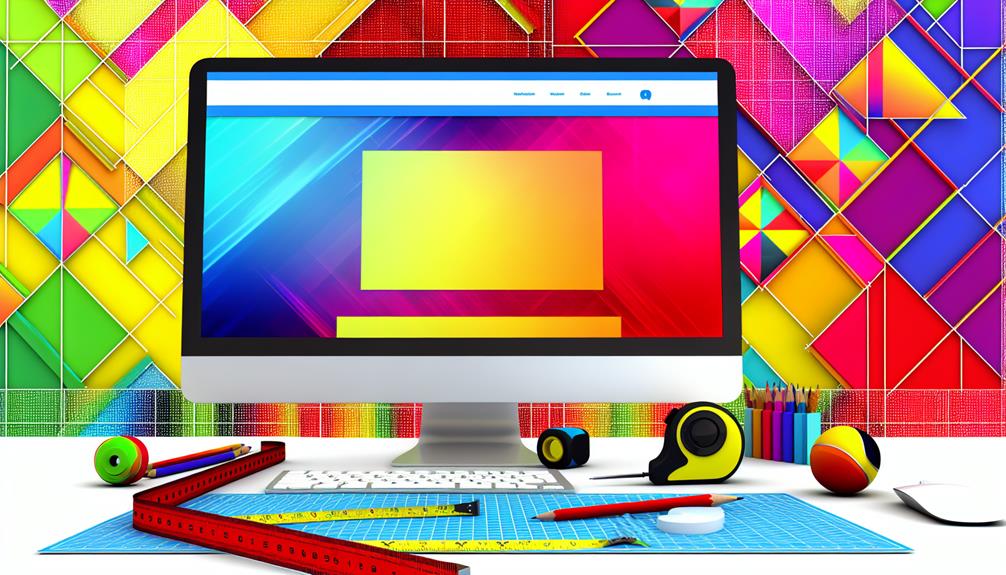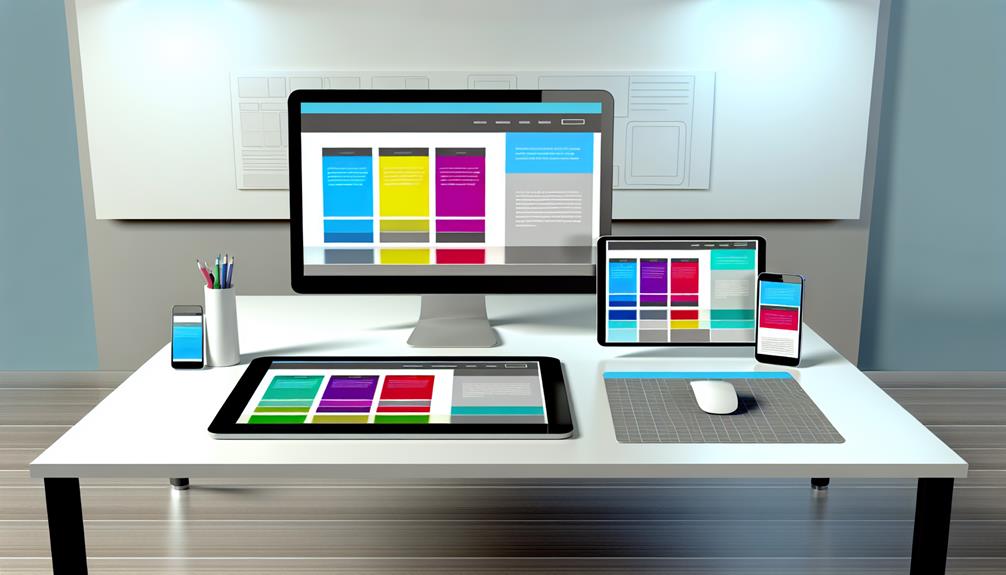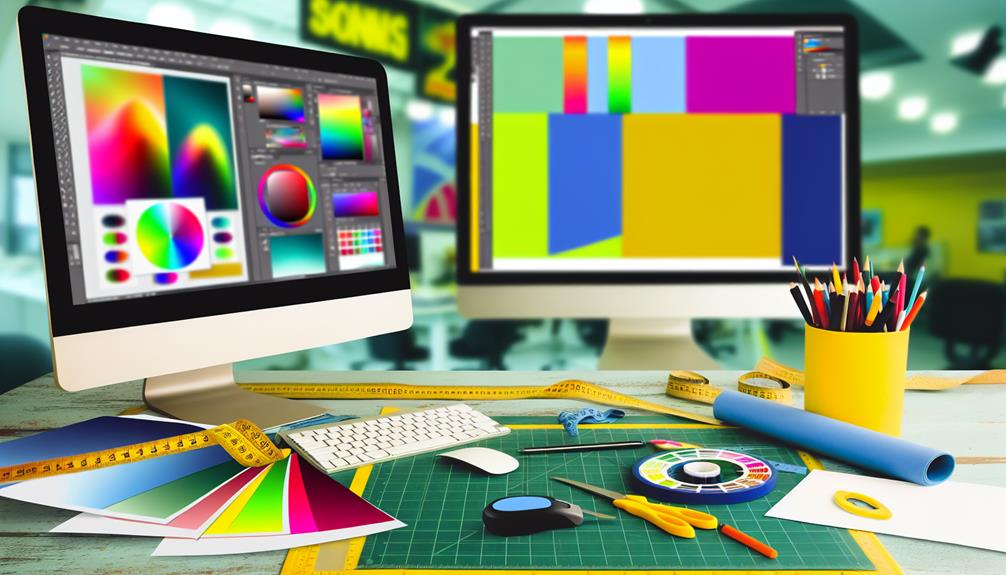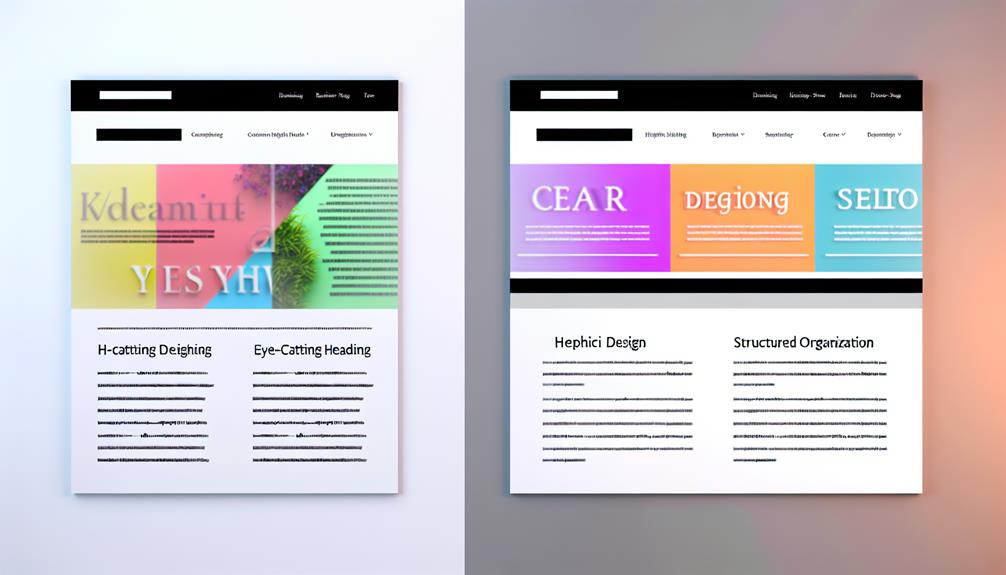Finding the ideal banner size for Google Sites is essential for enhancing visual impact and usability. The recommended full-width dimensions are 1200 x 300 pixels, providing maximum visibility. For versatile layouts, an 800 x 200 pixel standard banner works well, while a mobile-friendly version should be 600 x 150 pixels. Responsive design is critical; banners must adapt seamlessly across devices without losing quality. Utilizing high-resolution images and maintaining consistent branding are also key. By implementing these guidelines, you'll not only elevate your website's aesthetic but also improve user engagement, inviting further exploration of design strategies.
Key Takeaways
- The ideal full-width banner size for Google Sites is 1200 x 300 pixels for optimal visibility and aesthetics.
- For versatility, a standard banner size of 800 x 200 pixels works well across various layouts.
- Ensure mobile-friendly designs with a banner size of 600 x 150 pixels for effective display on smartphones.
- Testing different banner sizes through A/B testing can help determine which dimensions resonate best with your audience.
- Utilize design tools like Canva and Adobe Express to create custom banners that align with your brand identity.
Importance of Banner Size

When designing a Google Sites page, understanding the importance of banner size is crucial, as it directly impacts both the aesthetic appeal and functionality of the site. A well-crafted banner serves as the visual cornerstone of your webpage, drawing visitors in and providing an immediate impression of your brand identity. The appropriate banner size not only enhances the visual impact but also guarantees that your message is communicated effectively without distortion or loss of clarity. Additionally, incorporating elements that promote well-being, like walking, can inspire a more engaging user experience, as Tim McGraw highlights walking's health benefits.
Moreover, branding consistency is essential for fostering a sense of belonging among your audience. Utilizing a banner that aligns with your branding guidelines—color schemes, typography, and imagery—reinforces your brand's identity and cultivates a cohesive experience across all digital platforms. A properly sized banner allows for seamless integration with other site elements, creating a unified design that enhances user navigation.
In today's digital landscape, where first impressions can dictate user engagement, prioritizing the right banner size is not merely a design choice; it is a strategic decision that supports your overarching goals. By investing time in this critical aspect of your site, you are taking a significant step toward establishing a compelling online presence.
Recommended Banner Dimensions
Choosing the right banner dimensions is a critical step in optimizing your Google Sites page for both aesthetics and functionality. Just like Kelly Clarkson's dedication to her inspiring weight loss journey highlights the importance of making intentional choices, the dimensions you select directly influence banner visibility and help reinforce your brand consistency. Here are the recommended banner dimensions to take into account for an impactful design:
1. Full-Width Banner: 1200 x 300 pixels
This size guarantees your banner spans the entire width of the page, making it ideal for maximum visibility and engagement.
2. Standard Banner: 800 x 200 pixels
A versatile option that balances aesthetics and functionality, suitable for various layouts while maintaining brand integrity.
3. Mobile-Friendly Banner: 600 x 150 pixels
Designed specifically for mobile devices, this dimension guarantees your banner remains visually appealing and consistent across platforms.
Responsive Design Considerations

Understanding responsive design is essential for creating a Google Sites banner that looks great across all devices and screen sizes. As users increasingly access websites through smartphones and tablets, mobile optimization becomes paramount to guarantee your banner effectively captures attention. A responsive banner automatically adjusts its dimensions, layout, and content to provide an ideal viewing experience, enhancing user engagement. Additionally, incorporating elements that resonate with health-conscious audiences, such as the benefits of nutritious foods like yellow dragon fruit, can further engage visitors and encourage interaction.
When designing your banner, consider how elements will scale on various devices. For instance, text size and imagery must remain legible and visually appealing, regardless of whether the user is on a desktop or mobile device. Using vector graphics can help maintain image quality, while CSS media queries can allow for tailored design adjustments based on screen resolution.
Moreover, maintaining a consistent brand identity across platforms fosters a sense of belonging for your audience. Users are more likely to engage with content that feels cohesive, whether they are browsing on a laptop or a smartphone. Ultimately, investing time in responsive design considerations not only elevates the aesthetic appeal of your Google Sites banner but also enhances overall user experience, making your website a welcoming digital space.
Creating a Custom Banner
Creating a custom banner for Google Sites involves several key factors that can greatly enhance your website's visual appeal and effectiveness. A well-designed banner serves as the focal point of your site, establishing a strong visual identity through effective banner branding. Additionally, incorporating elements that resonate with healthy choices can create a positive impression on your audience, similar to how low-calorie snacks aid in weight loss. Here are three essential elements to reflect on when creating your custom banner:
- Dimensions and Layout: Verify you adhere to the ideal banner size for Google Sites, typically around 1600 x 400 pixels. This size helps maintain clarity across devices while optimizing loading times.
- Custom Graphics: Incorporate unique custom graphics that reflect your brand's ethos. This could include logos, color schemes, and thematic elements relevant to your content, fostering a sense of connection with your audience.
- Typography and Messaging: Choose fonts and messaging that resonate with your target audience. Clear, legible typography paired with concise messaging can improve user engagement and convey your brand's values effectively.
Tools for Designing Banners

In the process of designing effective banners for Google Sites, utilizing the right tools is essential for achieving ideal results. Incorporating yoga poses for flexibility can also inspire creativity and focus during the design phase. A variety of online design tools, graphic design software, and template resources are available to streamline the creation process and enhance visual appeal. By leveraging these resources, users can guarantee their banners not only meet size specifications but also resonate with their intended audience.
Online Design Tools
Designing an engaging banner for Google Sites can greatly enhance the visual appeal of your web presence. Effective online design tools not only facilitate the creation of visually striking banners but also contribute to a better user experience by aligning with current design trends. These tools empower users to craft banners that resonate with their audience and reflect their brand identity.
Here are three prominent online design tools that can elevate your banner creation process:
- Canva: This user-friendly platform offers a plethora of templates and design elements, making it easy to create professional-looking banners tailored to your specifications.
- Adobe Express: With its extensive library of design assets and customizable features, Adobe Express allows for intricate designs while maintaining simplicity in usage, ensuring that even novices can achieve stunning results.
- Visme: This versatile tool combines presentation and infographic features, enabling users to design interactive banners that capture attention and enhance engagement on their Google Sites.
Utilizing these online design tools can markedly improve your banner's aesthetic appeal and overall user experience, ensuring your website stands out in a competitive digital landscape.
Graphic Design Software
Graphic design software plays an essential role in the development of mesmerizing banners for Google Sites, offering users advanced tools and functionalities that elevate their creative potential. Utilizing graphic design principles such as balance, contrast, and visual hierarchy, these software solutions enable users to craft banners that not only capture attention but also convey meaningful messages.
To guide your banner creation journey, consider the following features of popular graphic design software:
| Software | Key Features | Best For |
|---|---|---|
| Adobe Illustrator | Vector graphics, typography | Professional designers |
| Canva | Templates, drag-and-drop | Beginners and quick projects |
| Figma | Collaboration, prototyping | Team projects and web design |
| Affinity Designer | Cost-effective, versatile tools | Freelancers and enthusiasts |
Template Resources Available
A plethora of template resources is available to streamline the banner design process for Google Sites, catering to varying skill levels and project requirements. These resources not only ease the design process but also enhance the overall aesthetic appeal of your website. With an array of template customization options, users can personalize their designs to align with their branding and message.
Consider the following resources for your banner design:
- Canva: Offers a vast library of pre-made templates tailored for Google Sites, featuring intuitive drag-and-drop functionality.
- Visme: Provides customizable banner templates with advanced graphic design features, perfect for users seeking more sophisticated designs.
- Adobe Express: Known for its robust design tools, this platform features an extensive collection of pre-made templates, allowing for seamless integration with Google Sites.
Testing Your Banner Size
How can you guarantee that your banner size is perfectly optimized for Google Sites? The key lies in employing effective banner testing methods. Start by creating multiple banner iterations, varying dimensions and design elements to assess which resonates best with your audience. Utilize A/B testing to compare the performance of different sizes, measuring engagement metrics such as click-through rates and time spent on the page.
Gather effective feedback from users through surveys or direct observations. This qualitative data complements quantitative metrics, providing a holistic view of your banner's performance. Engage your audience by asking specific questions about their visual experience—what captures their attention, and what might detract from it?
Additionally, ascertain that your banner maintains responsiveness across devices. Test it on various screen sizes to confirm that it remains visually appealing and functional, regardless of the platform. Regularly revisiting and refining your banner size based on data and user input fosters a sense of belonging and community among your audience. Their preferences should guide your design decisions, ensuring that your Google Sites banner not only fits seamlessly but also enhances the user experience.
Common Mistakes to Avoid

When creating a banner for Google Sites, several common pitfalls can undermine its effectiveness. Failing to maintain the correct aspect ratio, overcomplicating design elements, and selecting low-quality images can detract from the overall visual appeal and functionality of the site. Addressing these issues is essential for achieving a professional and engaging banner that enhances user experience.
Ignoring Aspect Ratio
Frequently, users overlook the importance of aspect ratio when designing their Google Sites banners, leading to suboptimal visual presentations. The aspect ratio is an essential element that greatly influences the banner size impact and overall aesthetic of your site. Failing to take this into account can result in distorted images or awkward cropping, detracting from user experience.
To guarantee your banner aligns well with your content and maintains a professional look, keep the following points in mind:
- Standard Aspect Ratios: Familiarize yourself with common ratios like 16:9 or 4:3 to maintain consistency and visual harmony across different devices.
- Responsive Design: Choose an aspect ratio that adapts well to various screen sizes, ensuring your banner looks appealing on both desktops and mobile devices.
- Testing and Adjustment: Regularly preview your banner on different devices to assess the visual impact and make necessary adjustments to uphold quality.
Overcomplicating Design Elements
What elements truly enhance a Google Sites banner without overwhelming it? The key lies in embracing design simplicity and guaranteeing visual clarity. Overcomplicating design elements can muddle your message and distract viewers from the core content. When crafting a banner, prioritize essential components that resonate with your audience.
Consider the use of a limited color palette; this not only maintains visual cohesion but also fosters a sense of belonging for viewers. Complex patterns, excessive graphics, or overly intricate fonts can detract from the intended impact. Instead, focus on clean lines and straightforward typography that reinforces your brand identity.
Whitespace is equally critical—it allows the eye to rest, guiding viewers smoothly through your design. By avoiding clutter, you create a more inviting atmosphere and enhance the overall user experience.
Furthermore, verify that any added elements, such as logos or taglines, are thoughtfully integrated into the design, serving a clear purpose rather than merely filling space. To conclude, achieving a well-balanced Google Sites banner hinges on the ability to strip away distractions and embrace a philosophy of design simplicity, ultimately leading to compelling visual clarity.
Using Low-Quality Images
An effective Google Sites banner demands high-quality images that resonate with viewers and enhance the overall design. Using low-quality images can severely compromise the visual appeal and professionalism of your website. To guarantee your banner communicates your intended message effectively, consider the following key points regarding image quality and pixel density:
- Select High-Resolution Images: Always use images with a resolution of at least 300 DPI (dots per inch) for peak clarity. Low-resolution images can appear pixelated and unprofessional.
- Maintain Aspect Ratio: Images should maintain their aspect ratio when resized. Stretching or compressing images can distort their appearance and reduce overall quality.
- Optimize for Fast Loading: While high image quality is essential, guarantee that images are optimized for web use. This means balancing quality with file size to enhance loading times without sacrificing visual integrity.
Optimizing for Different Devices
Ensuring ideal display across various devices requires careful attention to the banner size used in Google Sites. Mobile optimization is essential, as a significant portion of users access websites through smartphones. The banner must be designed with screen adaptability in mind, ensuring it scales properly across different screen sizes, from small mobile displays to larger tablets.
When considering tablet layout, the banner should maintain visual integrity and coherence with the overall design. Desktop variation is equally important; larger screens offer more real estate, allowing for a more expansive design that should not compromise user experience. Consistency in design across devices fosters a sense of reliability and belonging for users.
Image scaling plays a pivotal role in this optimization, as it directly impacts how users perceive the content. A well-optimized banner should avoid pixelation while maintaining high-quality visuals. Additionally, the navigation impact of the banner cannot be overlooked; it should enhance the user's ability to explore the website effortlessly. By prioritizing these factors, you create a seamless experience that resonates with visitors, making them feel welcomed and engaged, whether they are on a mobile device, tablet, or desktop.
Final Tips for Success

Achieving success with your Google Sites banner involves a combination of strategic design choices and technical considerations. To create a visually appealing and effective banner, it is essential to focus on three key elements that contribute to your site's identity and user engagement.
- Color Schemes: Select a color palette that aligns with your brand's identity and evokes the desired emotions. Harmonious color combinations can enhance the visual appeal and make your site memorable.
- Font Choices: Choose fonts that are not only aesthetically pleasing but also legible across devices. Mixing different font styles can create emphasis and guide viewers' attention to critical information without sacrificing readability.
- Image Quality: Use high-resolution images that complement your design. Blurry or pixelated images can undermine your professionalism and detract from the overall impact of your banner.
Frequently Asked Questions
Can I Use Animated Banners on Google Sites?
Yes, you can use animated banners on Google Sites, which offer several benefits, including increased engagement and enhanced visual appeal. To maximize their effectiveness, consider creative design tips such as maintaining a balance between animation speed and clarity, ensuring that the animations align with your website's overall theme, and keeping file sizes optimized for faster loading. Thoughtful implementation fosters a sense of belonging and connection among your audience, enriching their online experience.
What File Formats Are Best for Google Sites Banners?
When selecting file formats for Google Sites banners, consider using PNG or JPEG for maximum image resolution and quality. PNGs are ideal for images requiring transparency and sharpness, while JPEGs are suitable for photographs where file size might be a concern. In conjunction with effective banner design tips, these formats guarantee a visually appealing and professional appearance, enhancing user engagement and fostering a sense of belonging within your online community.
How Do I Upload My Banner to Google Sites?
To upload your banner to Google Sites, navigate to your site and select the "Header" section. Click on "Change image," then choose "Upload" to select your banner file. For ideal results, follow banner design tips such as confirming the image dimensions align with Google Sites customization guidelines. Once uploaded, adjust the positioning as necessary and preview the changes to verify your banner complements the overall site aesthetic, fostering a cohesive and inviting online environment.
Are There Any Color Restrictions for Banner Designs?
While there are no strict color restrictions for banner designs, it is essential to contemplate color psychology and branding consistency. Colors evoke emotions and can greatly influence audience perception. Selecting colors that align with your brand identity fosters recognition and trust. Additionally, ensuring your color palette resonates with your target audience enhances their sense of belonging. By thoughtfully choosing colors, you create an inviting and cohesive visual experience that effectively communicates your brand message.
How Do Banner Sizes Affect Website Loading Speed?
Banner sizes greatly influence website loading speed, primarily through image optimization. Larger images can increase loading times, negatively impacting user experience and engagement. By adhering to responsive design principles, banners can be resized for different devices, ensuring quick loading without sacrificing aesthetic quality. Optimized images enhance the overall performance of a website, fostering a sense of belonging among users who appreciate efficient, visually appealing interfaces that cater to their diverse needs and preferences.




